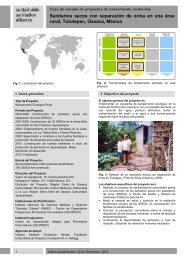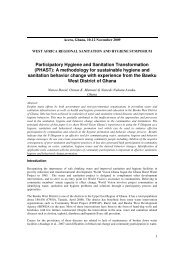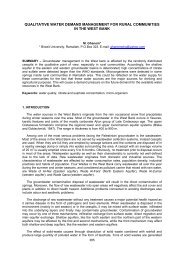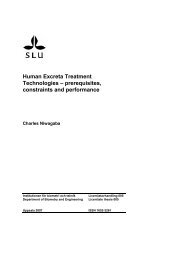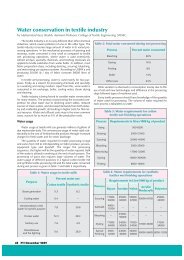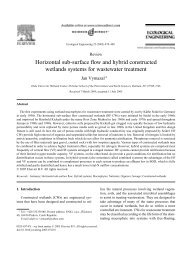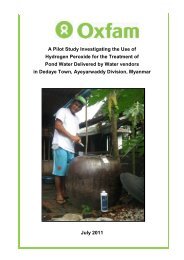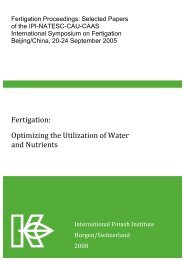Compilation of 13 factsheets on key sustainable sanitation ... - SSWM
Compilation of 13 factsheets on key sustainable sanitation ... - SSWM
Compilation of 13 factsheets on key sustainable sanitation ... - SSWM
You also want an ePaper? Increase the reach of your titles
YUMPU automatically turns print PDFs into web optimized ePapers that Google loves.
would include the effective payment (market price) for<br />
water minus cost <str<strong>on</strong>g>of</str<strong>on</strong>g> transfer 4<br />
.<br />
• Households who reuse their waste do not need to pay<br />
for pit emptying services or build a new pit when the old<br />
<strong>on</strong>e is full.<br />
Many <str<strong>on</strong>g>of</str<strong>on</strong>g> the argued (or predicted) benefits <str<strong>on</strong>g>of</str<strong>on</strong>g> reuse oriented<br />
sanitati<strong>on</strong> are heavily related to c<strong>on</strong>text-specific programme<br />
c<strong>on</strong>diti<strong>on</strong>s. For instance, the extent <str<strong>on</strong>g>of</str<strong>on</strong>g> the benefit will be<br />
closely related to the degree <str<strong>on</strong>g>of</str<strong>on</strong>g> community acceptance <str<strong>on</strong>g>of</str<strong>on</strong>g><br />
excreta reuse, hygiene behaviour change and other factors<br />
that determine successful adopti<strong>on</strong> <str<strong>on</strong>g>of</str<strong>on</strong>g> technologies.<br />
Figure 6: A stove in a school kitchen running <strong>on</strong> biogas produced<br />
from human excreta in Rilima, Rwanda (source: P. Feiereisen,<br />
2011). More photos <strong>on</strong> this school: www.flickr.com/photos/<br />
gtzecosan/sets/72157627230220319/with/6008002835/.<br />
6 Tools for financial and ec<strong>on</strong>omic analysis<br />
Whole life-cycle analysis involves a l<strong>on</strong>g term perspective<br />
which takes into account all costs incurred and benefits<br />
received over the total durati<strong>on</strong> <str<strong>on</strong>g>of</str<strong>on</strong>g> the planned project<br />
(including operati<strong>on</strong> as well as c<strong>on</strong>structi<strong>on</strong>), which is<br />
known as the planning horiz<strong>on</strong>. Depending <strong>on</strong> the type <str<strong>on</strong>g>of</str<strong>on</strong>g><br />
asset, the quality <str<strong>on</strong>g>of</str<strong>on</strong>g> c<strong>on</strong>structi<strong>on</strong> and the chosen planning<br />
horiz<strong>on</strong>, the design life for individual comp<strong>on</strong>ents <str<strong>on</strong>g>of</str<strong>on</strong>g> the<br />
sanitati<strong>on</strong> system may be greater than or smaller than the<br />
planning horiz<strong>on</strong>.<br />
A c<strong>on</strong>cept similar to the accounting term <str<strong>on</strong>g>of</str<strong>on</strong>g> asset<br />
“depreciati<strong>on</strong>” encourages l<strong>on</strong>g-term thinking and<br />
investment in technologies that are financially <strong>sustainable</strong>.<br />
For a comparis<strong>on</strong> bey<strong>on</strong>d specific requirements <str<strong>on</strong>g>of</str<strong>on</strong>g><br />
programme implementers or nati<strong>on</strong>al governments, some<br />
basic tools and ratios are helpful for comparing sanitati<strong>on</strong><br />
interventi<strong>on</strong>s with respect to m<strong>on</strong>etary as well as n<strong>on</strong>m<strong>on</strong>etary<br />
outcomes, and from several perspectives.<br />
Costs can be annualised to aid judgments about<br />
affordability. Costs expressed in local currency and in real<br />
4 Until now the cost saving that can be achieved with treated<br />
wastewater is still however close to zero in most countries, but the<br />
c<strong>on</strong>cept might have importance in the future.<br />
prices <str<strong>on</strong>g>of</str<strong>on</strong>g> the base year <str<strong>on</strong>g>of</str<strong>on</strong>g> the study (i.e. without inflati<strong>on</strong>) are<br />
most appropriate for financial analyses where the results are<br />
to be used to support nati<strong>on</strong>al or sub-nati<strong>on</strong>al level decisi<strong>on</strong>making.<br />
The discount rate used should reflect the<br />
opportunity costs <str<strong>on</strong>g>of</str<strong>on</strong>g> capital in a given nati<strong>on</strong>al ec<strong>on</strong>omy. If<br />
there is no accepted nati<strong>on</strong>al discount rate, ec<strong>on</strong>omists<br />
frequently use a discount rate <str<strong>on</strong>g>of</str<strong>on</strong>g> 5%.<br />
While providing the results <str<strong>on</strong>g>of</str<strong>on</strong>g> financial and ec<strong>on</strong>omic<br />
analyses to potential users, measures such as the costeffectiveness<br />
ratio, Benefit-Cost Ratio (BCR), Net Present<br />
Value (NPV), or Internal Rate <str<strong>on</strong>g>of</str<strong>on</strong>g> Return (IRR) can be utilised.<br />
In each case, the tools are essentially the same for financial<br />
and ec<strong>on</strong>omic analyses; but the input data will <str<strong>on</strong>g>of</str<strong>on</strong>g> course<br />
vary. Only larger programmes will justify research and full<br />
cost-benefit analysis. In these cases, the ratio <str<strong>on</strong>g>of</str<strong>on</strong>g> total<br />
benefits divided by total costs or the internal rate <str<strong>on</strong>g>of</str<strong>on</strong>g> return<br />
can provide additi<strong>on</strong>al informati<strong>on</strong> for policies and decisi<strong>on</strong>s.<br />
a) Cost-effectiveness ratio<br />
The cost-effectiveness ratio is a more specific tool that<br />
compares costs with a single outcome <str<strong>on</strong>g>of</str<strong>on</strong>g> sanitati<strong>on</strong><br />
improvement, expressed in physical (n<strong>on</strong>-m<strong>on</strong>etary) units<br />
such as inhabitants better served, health gain or reducti<strong>on</strong> in<br />
polluti<strong>on</strong>. It is generally used in public sector planning.<br />
b) Benefit-Cost Ratio (BCR)<br />
The benefit-cost ratio (BCR) is calculated by dividing the<br />
discounted benefits by the discounted costs <str<strong>on</strong>g>of</str<strong>on</strong>g> the sanitati<strong>on</strong><br />
interventi<strong>on</strong>. 5<br />
This indicator can be used to compare different<br />
sanitati<strong>on</strong> improvement opti<strong>on</strong>s and to compare a sanitati<strong>on</strong><br />
opti<strong>on</strong> with ‘doing-nothing’. Two types <str<strong>on</strong>g>of</str<strong>on</strong>g> studies reporting<br />
BCRs can be distinguished: (i) those reporting the costs and<br />
benefits generally associated with improved sanitati<strong>on</strong> <strong>on</strong> a<br />
regi<strong>on</strong>al or nati<strong>on</strong>al level (‘macro’ studies); and (ii) those<br />
comparing the costs and benefits <str<strong>on</strong>g>of</str<strong>on</strong>g> alternative sanitati<strong>on</strong><br />
opti<strong>on</strong>s in a single c<strong>on</strong>text <strong>on</strong> the household level(‘micro’<br />
studies).<br />
c) Net Present Value (NPV)<br />
L<strong>on</strong>g-term outcomes <str<strong>on</strong>g>of</str<strong>on</strong>g> sanitati<strong>on</strong> interventi<strong>on</strong>s can be<br />
measured either in m<strong>on</strong>etary terms in cost-benefit analysis<br />
(CBA) or cost-effectiveness analysis (CEA). This is used to<br />
assess financial costs over a period <str<strong>on</strong>g>of</str<strong>on</strong>g> time and is<br />
particularly relevant where sanitati<strong>on</strong> projects achieve similar<br />
or identical outcomes. The narrower CEA can be used if<br />
valuati<strong>on</strong> <str<strong>on</strong>g>of</str<strong>on</strong>g> benefits is difficult; while CBA is a broader<br />
method that combines multiple impacts <str<strong>on</strong>g>of</str<strong>on</strong>g> improved<br />
sanitati<strong>on</strong> in a single framework expressed in m<strong>on</strong>etary<br />
units.<br />
For both CEA and CBA, the NPV is a comm<strong>on</strong> parameter for<br />
comparing sanitati<strong>on</strong> technologies, which can be expressed<br />
in financial and ec<strong>on</strong>omic terms. The calculati<strong>on</strong> <str<strong>on</strong>g>of</str<strong>on</strong>g> these two<br />
values is similar, but the input data and costing factors are<br />
different in each case.<br />
The combined investment and recurrent costs are expressed<br />
as a NPV over the useful lifetime <str<strong>on</strong>g>of</str<strong>on</strong>g> major investment<br />
comp<strong>on</strong>ents, and can be subtracted from the NPV <str<strong>on</strong>g>of</str<strong>on</strong>g><br />
5 The discount is the difference between the present amount and the<br />
amount in the future. The discount rate is usually given at 5% per<br />
year.<br />
Finance and ec<strong>on</strong>omics: Working Group 2 - page 6



